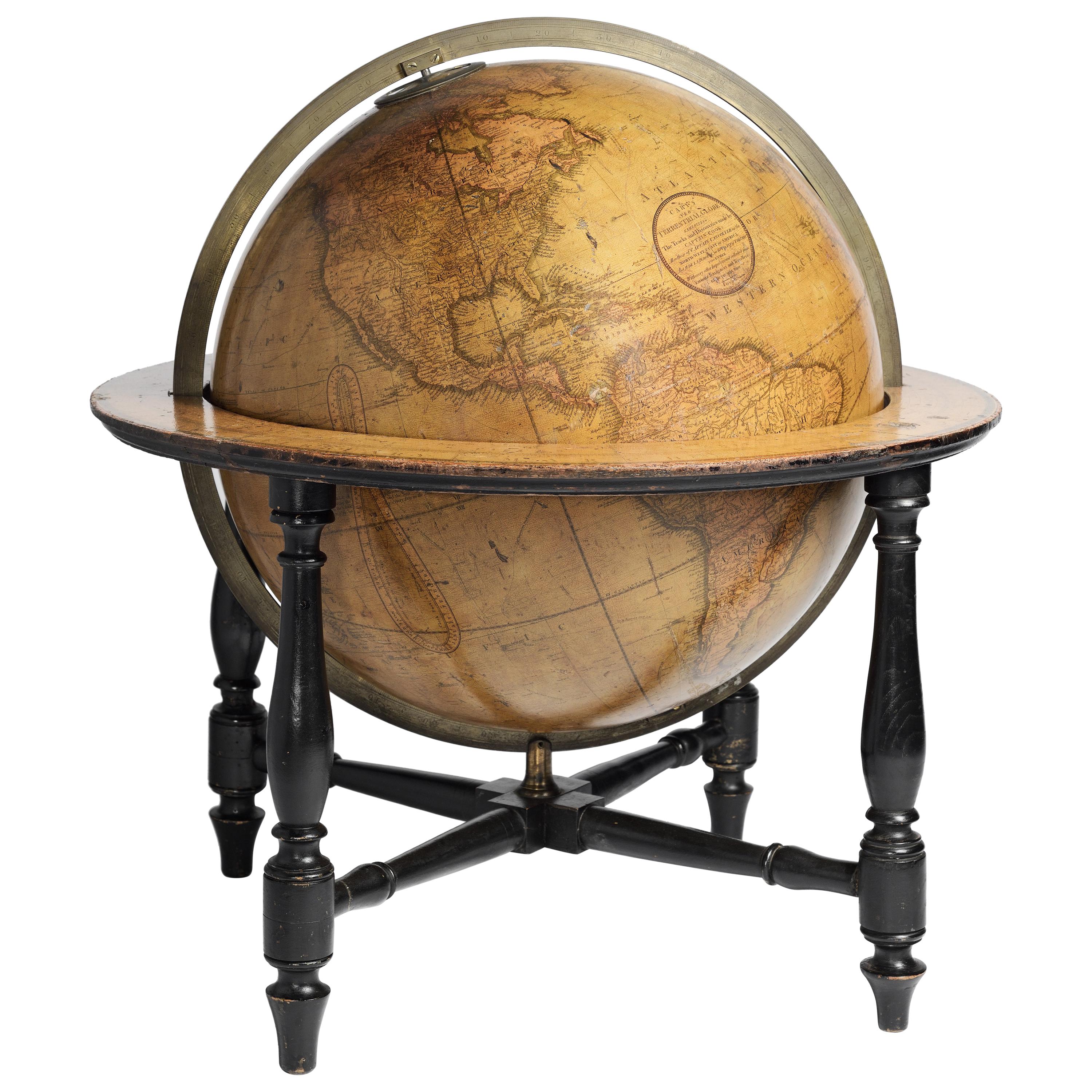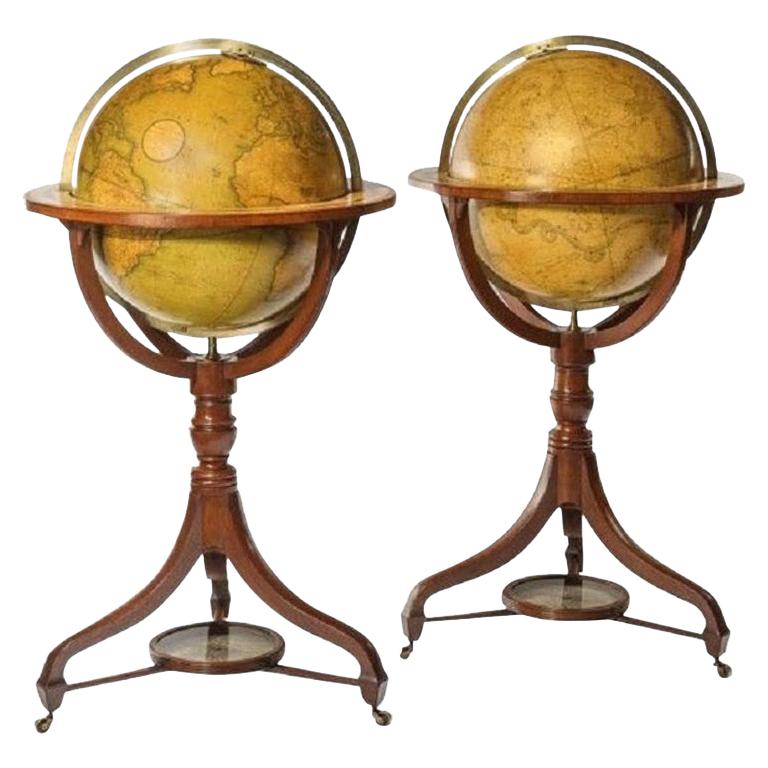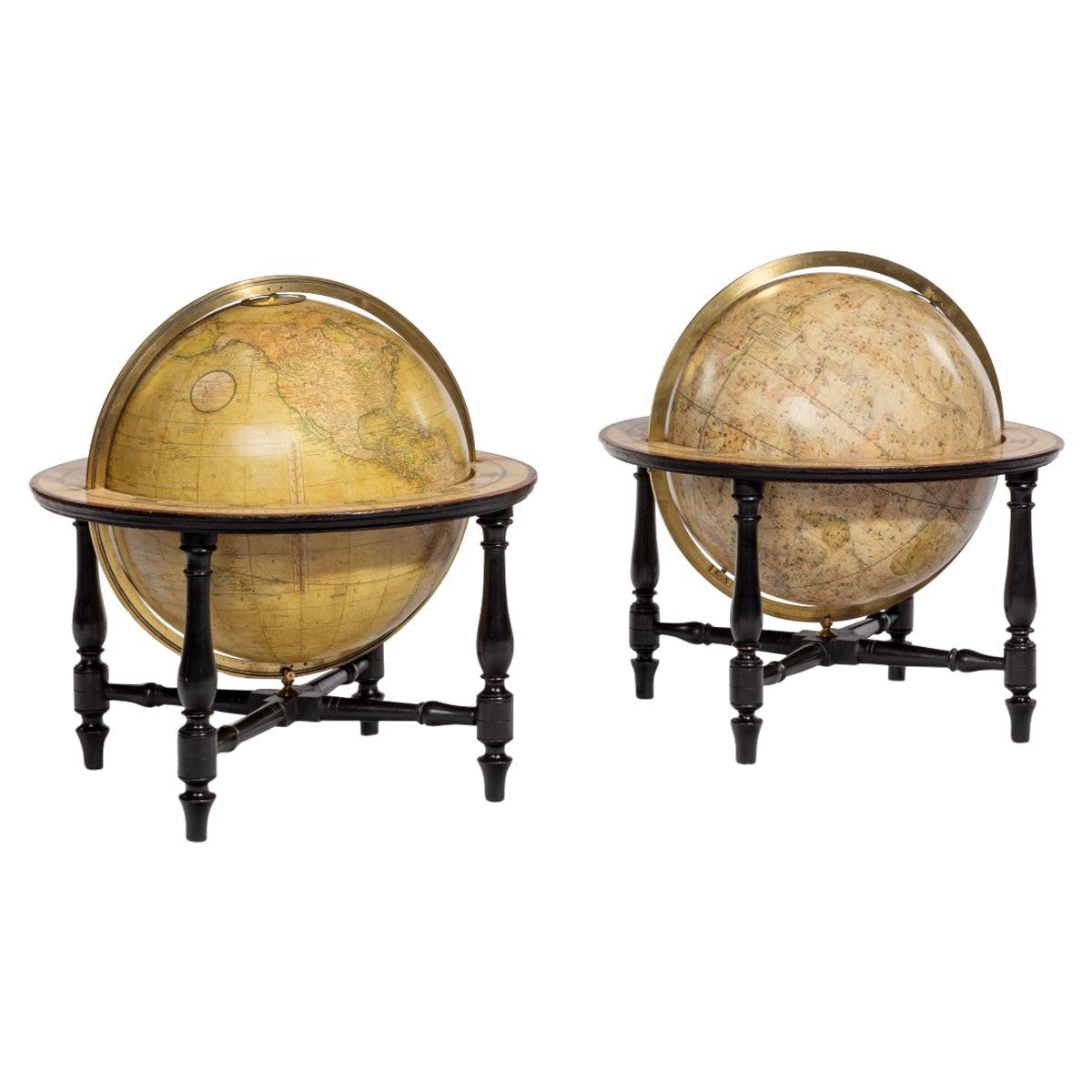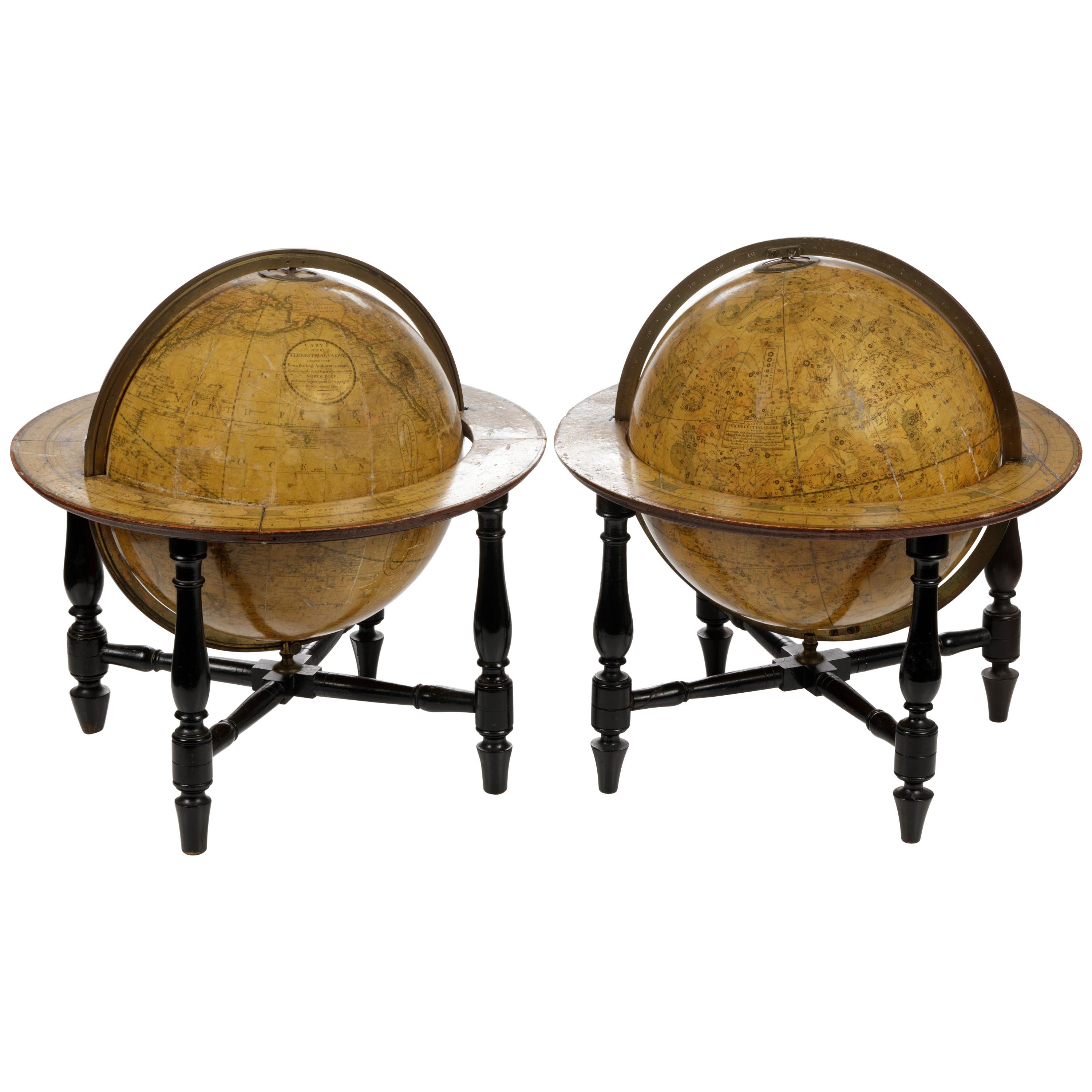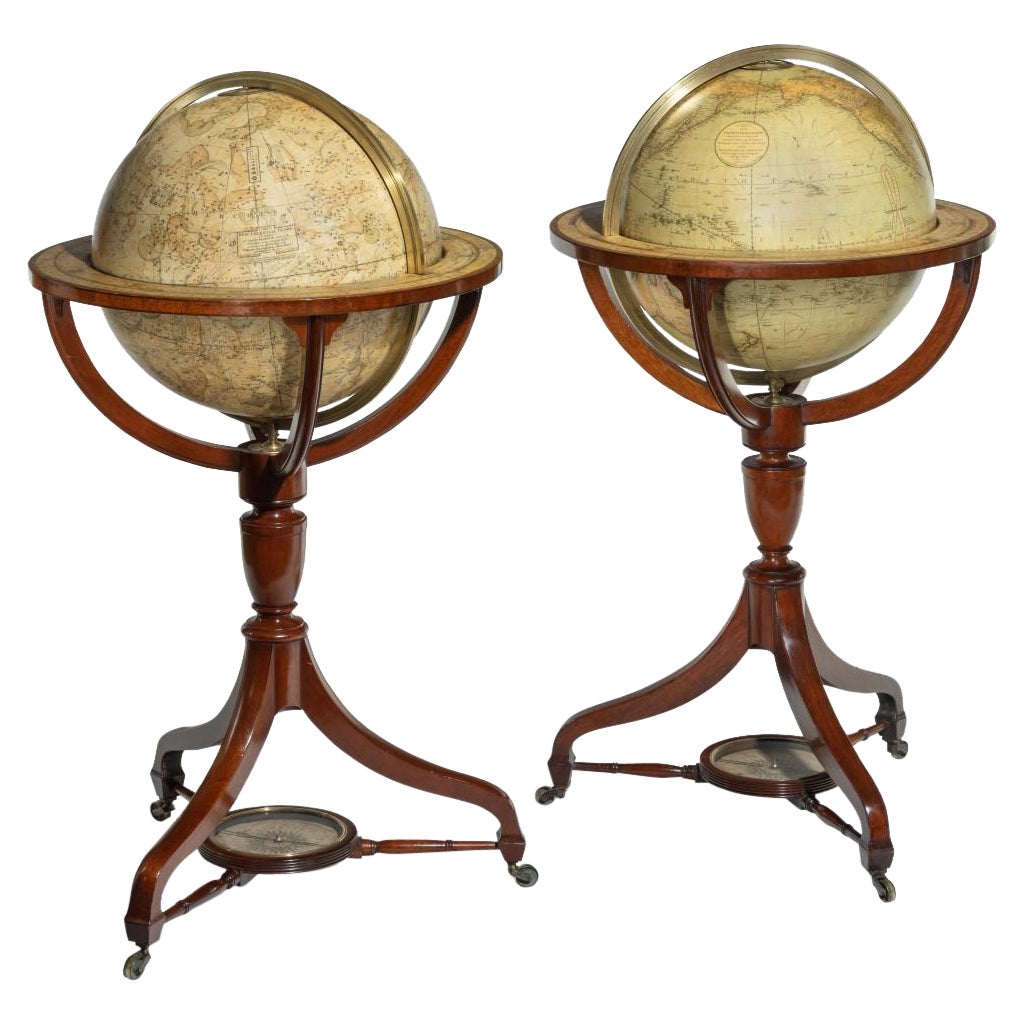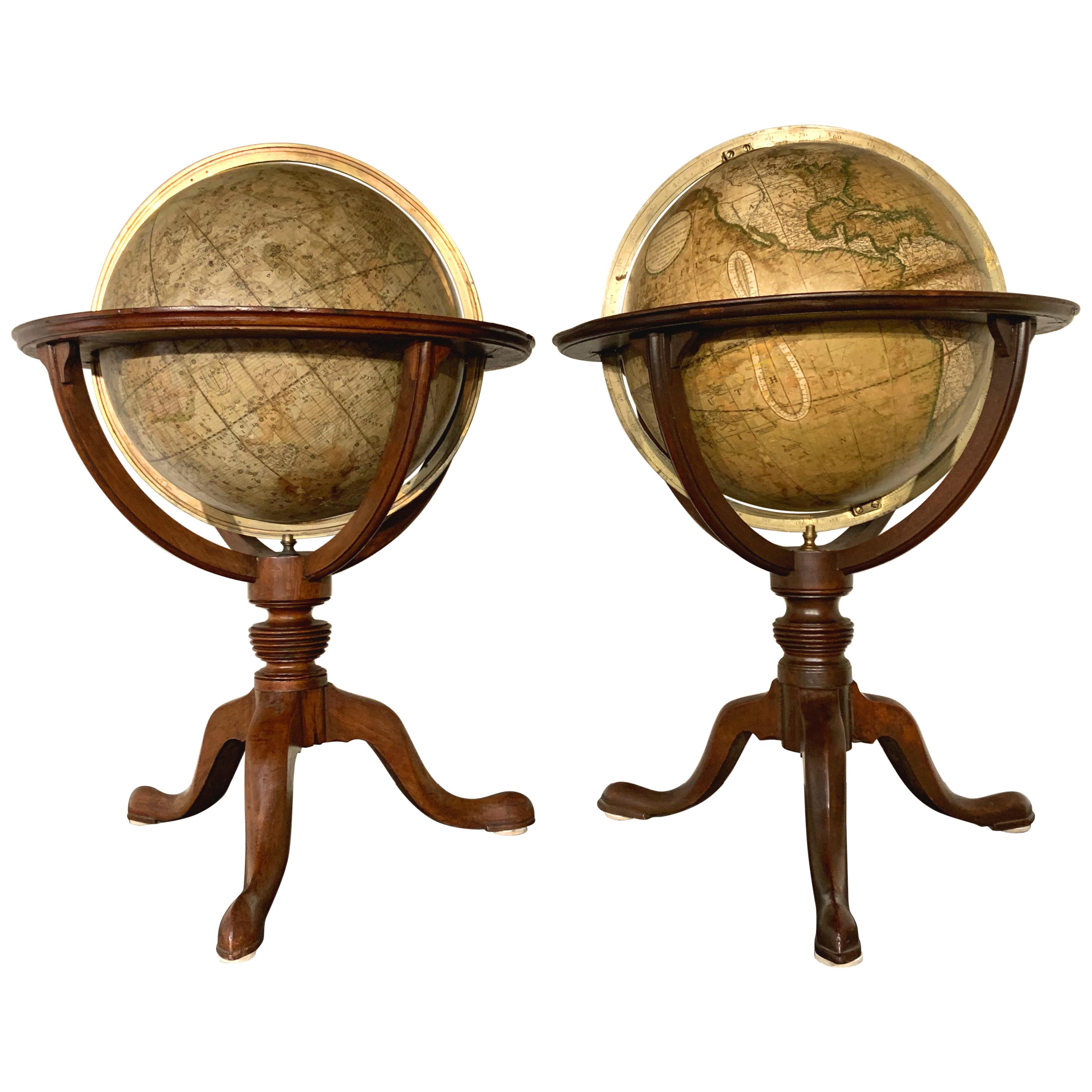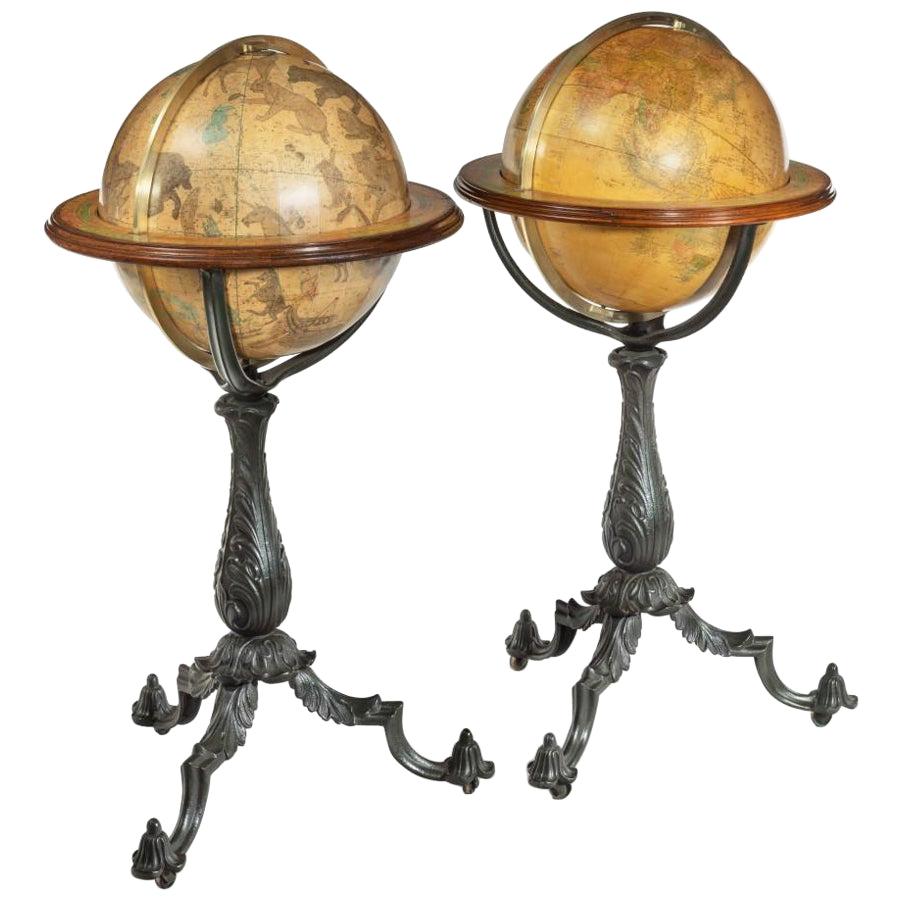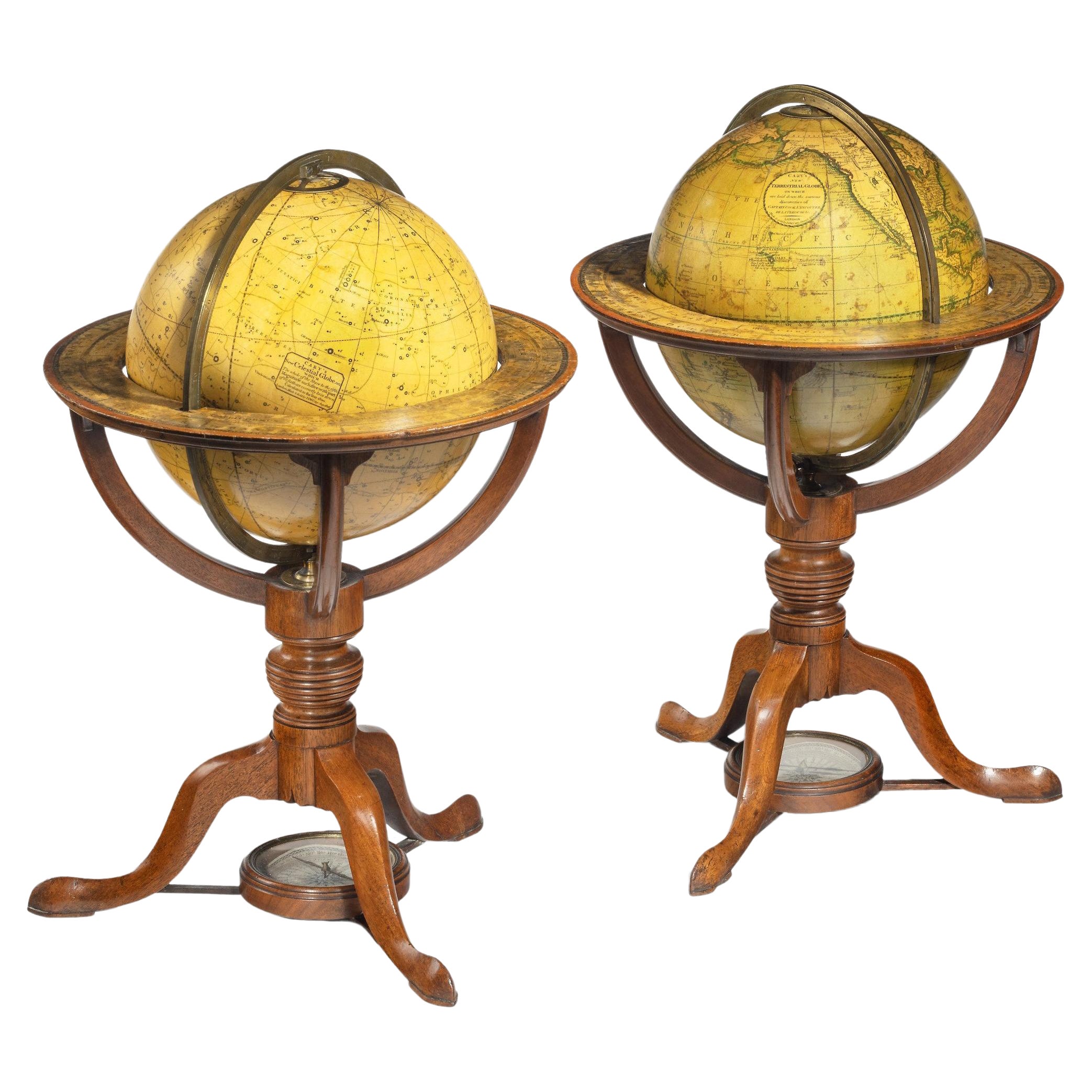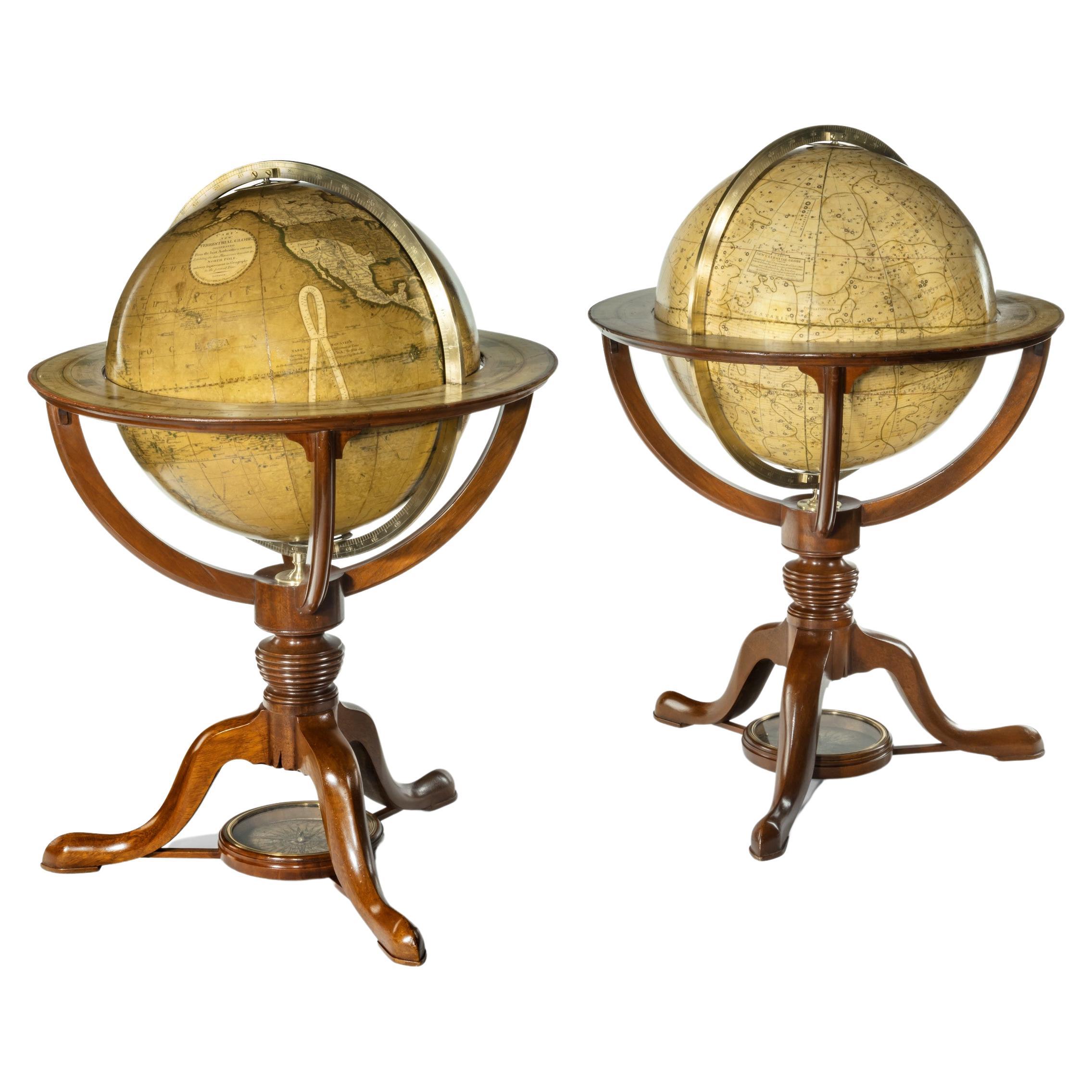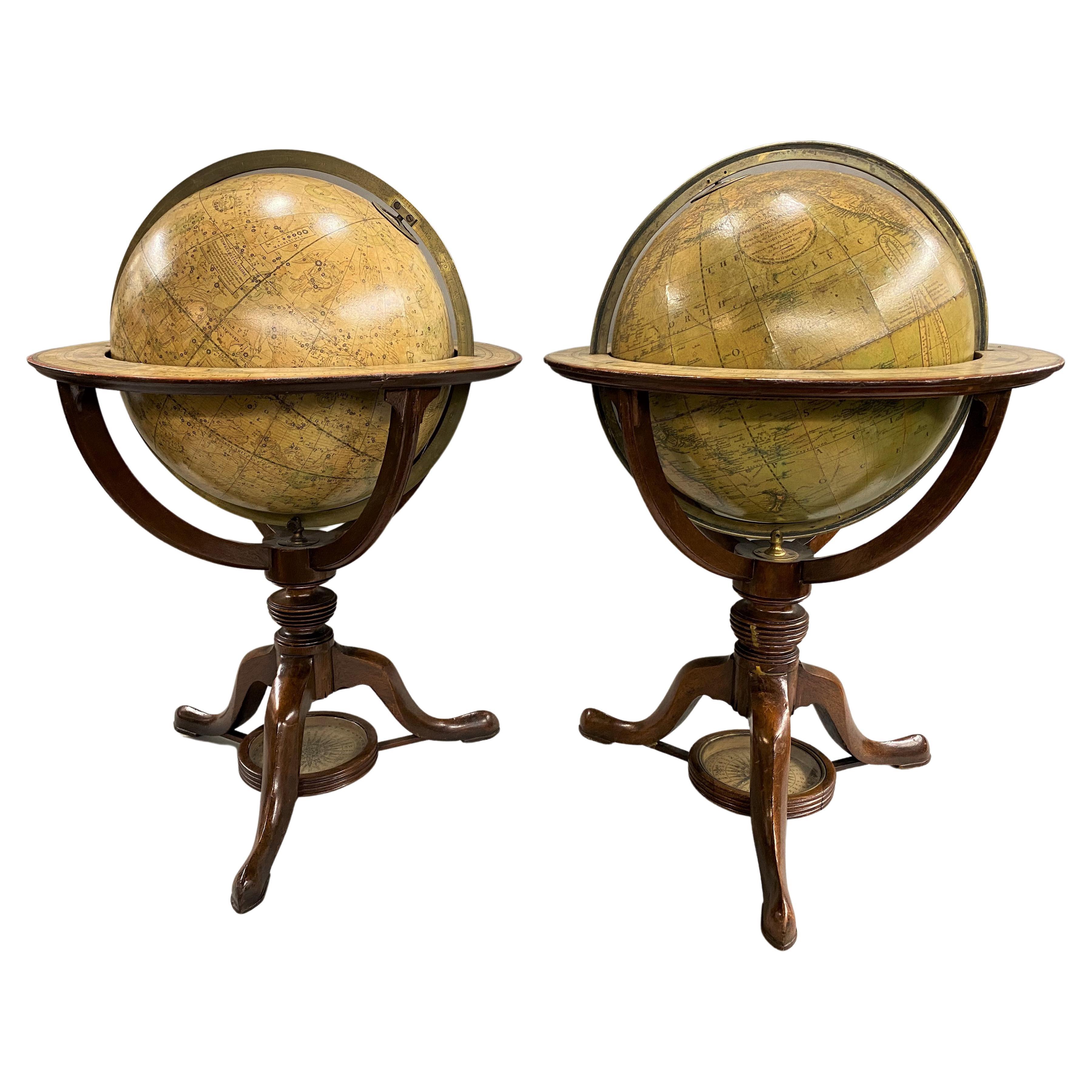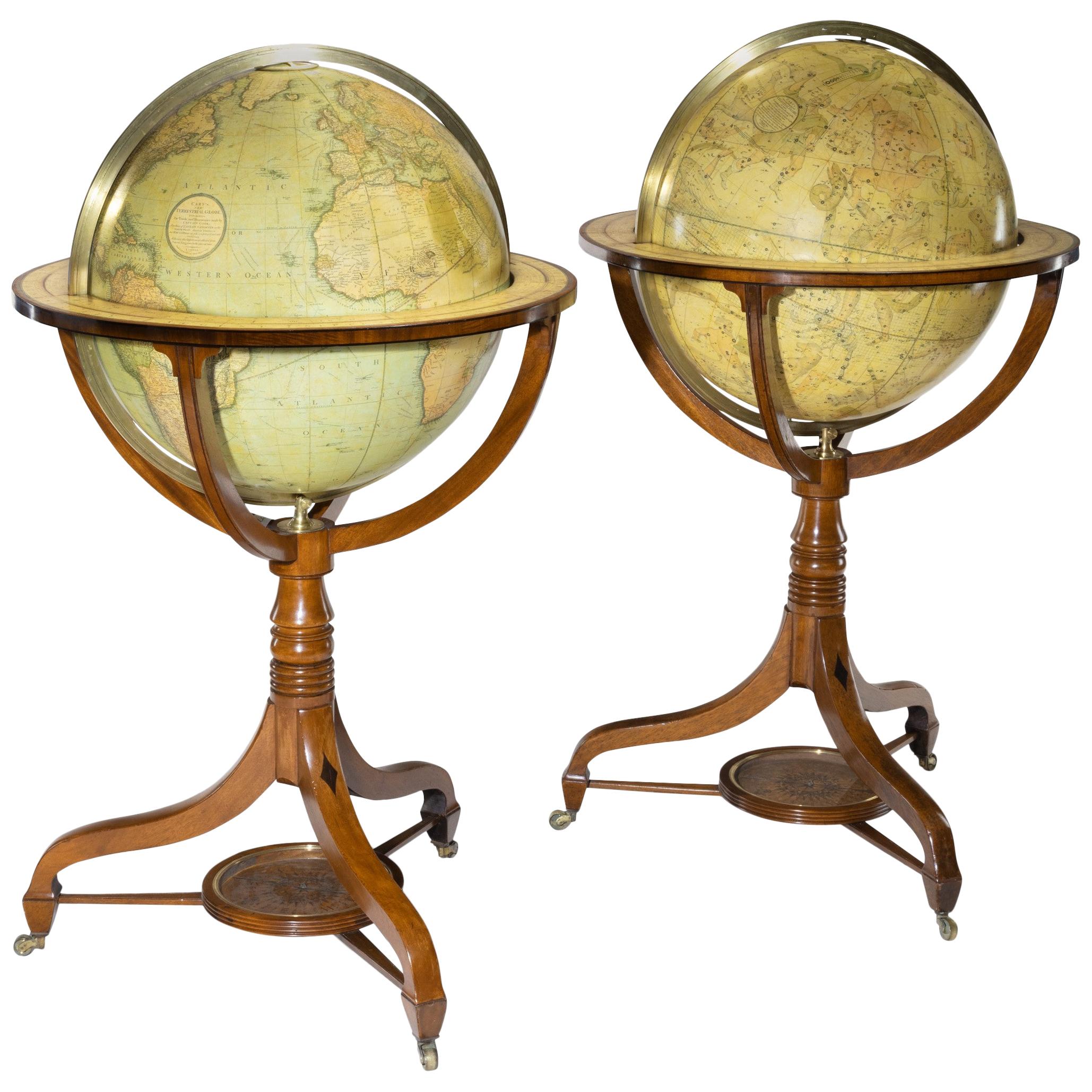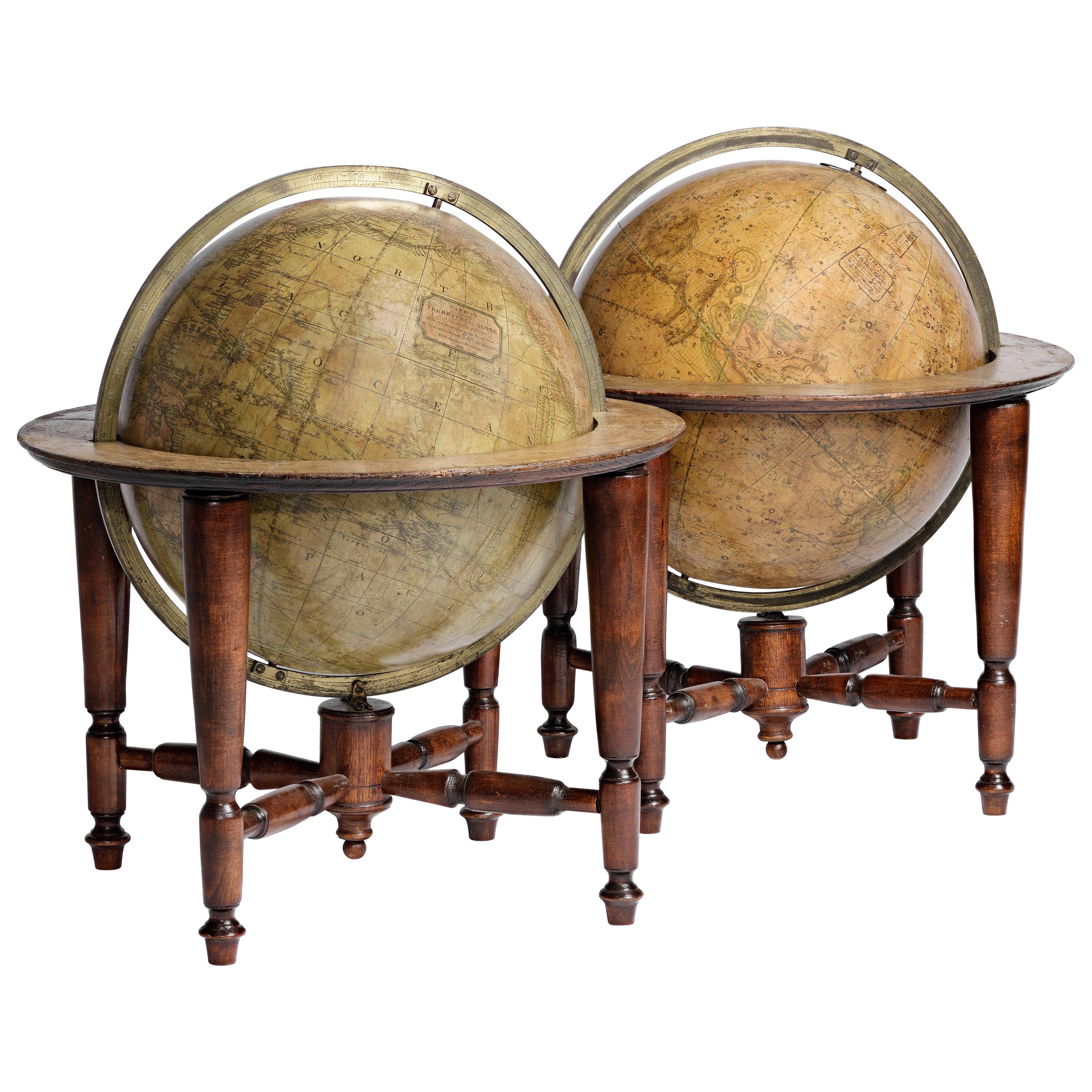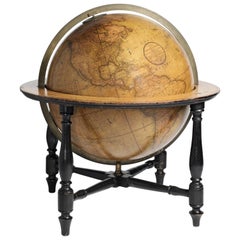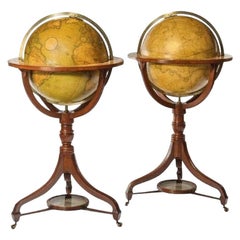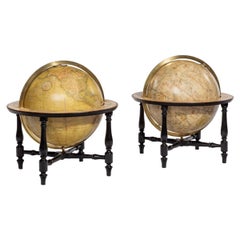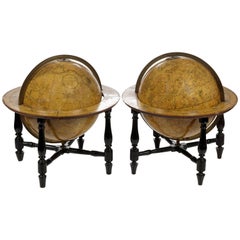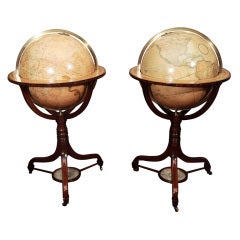
Monumental Pair of Cary's Library Globes
View Similar Items
1 of 9
Monumental Pair of Cary's Library Globes
About the Item
London: March 1799 (Celestial) & 1825 (Terrestrial)
Mahogany stands
A fine, rare and handsome pair of large English Regency terrestrial and celestial floor globes by J. & W. Cary, generally regarded as the greatest British globe makers of the late Georgian period. The terrestrial globe is dated 1825, showing early western exploration of the United States. The celestial globe is dated 1799 and is richly decorated with zodiac and other constellation figures. Both are raised on identical mahogany stands in the Georgian taste with compass stretchers.
Each globe is surmounted by brass hour disc at the North Pole, in a full graduated brass meridian, the horizon -- edged with cross banded veneer -- with hand-colored engraved paper ring showing degrees of amplitude and azimuth, compass directions, days and months of the year, names of the signs of the zodiac, and an equation of time. The globes are each supported by four incised mahogany quadrants joined to the horizon between pairs of ogee brackets, raised on a mahogany tripod stand with ring and baluster turned central standard, the splayed in-swept legs having ebonized diamond-form inlays, joined by compass stretcher with glazed round wooden compass case enclosing a paper compass card and magnetized metal needle, ending in spade feet on brass casters.
The terrestrial globe is mapped with detailed cartography, geographical entities in tones of cream, olive, and faded pink, with thick olive and thin pink outlining, and oceans in olive tones. Region west of Mississippi shown, from north to south, as "Missouri Ter.," "Great Desert," and Mexico. Southwest shown as "Unexplored Countries," and north of that as "Shoshones or Snake Ind." California shown as "New Albion," a name given to a cove on the Pacific coast by Sir Francis Drake, the first Englishman to sail around the world (1577-1580). Information from important exploratory voyages of the late 18th century was incorporated into the cartography of this globe. Noted on the cartouche are Captain James Cook's round-the-world voyages (1768-1780). Also noted are the discoveries of Cook's protégé Captain George Vancouver, sent by the British to map the northwest Pacific coast of North America, who named over 200 places and proved that the mythical "Northwest Passage" did not exist. The globe draws upon the mapping of the mainland Asian coast, then known as Tartary, by another admirer of Cook, the French admiral Jean-François de Galaup, Count de la Perouse (1741-88). Sent by the French government to collect scientific data, he led an expedition to the North American, South American and Asian coasts of the Pacific, and the islands of the South Pacific, on a voyage beginning in 1785. In 1788, he sent his journals and letters to Europe on a British ship, and shortly thereafter disappeared in a shipwreck.
Significantly, Cary terrestrial globes showed the rapidly evolving understanding of the geography of the American West. After the Louisiana Purchase in 1803, Meriwether Lewis and William Clark had been appointed by President Thomas Jefferson to explore the newly acquired territory. Their journeys, undertaken between 1804 and 1806, covered thousands of miles of wilderness, including the Missouri River, which they navigated between St. Louis and North Dakota, and their travels through what is now the Northwestern U.S. to the Oregon coast. Cary advertised that their globes included cartographic details derived from Lewis & Clark's report that was issued in 1812. This is the first time that the information from these remarkable discoveries was published on a globe. Beyond this key fact, this terrestrial globe was the first to juxtapose the Lewis and Clark discoveries with those of Zebulon Pike in the American Southwest, Stephen Long in Nebraska, Wyoming, Colorado, Oklahoma and Texas, Thomas Nutall in Arkansas and Andrew Ellicott on the border between Spanish Florida and the United States.
Thus these globes give to the American and European communities the first results of the magnificent discoveries that opened up North America to United States citizens and emmigrants from all over the world. The fire of manifest destiny burned much brighter as a result of this cornerstone globe.
The celestial globe is mapped with constellations elegantly depicted by mythical figures and scientific instruments in the Baroque taste, the zodiac belt within graph-form grid, the stars shown in a chart in successive orders of magnitude, together with planetary nebulae and clusters. The constellations are in tones of pink, grey, browns, and olive against a cream-colored background. An example of the celestial globe, same date and size, is in the collection of the Osterreichisches Staatsarchiv in Vienna, Austria (Allmayer-Beck). Another example in the Universiteitsmuseum of Utrecht is the same size and has the same design of stand but is dated 1815 (Dekker and van der Krogt, plate 37).
The celebrated Cary family of cartographers and globe makers produced some of the greatest late Georgian globes, and are often considered the best 19th century British globe maker. The firm was started in the late 18th century by John Cary, who often worked in partnership with his brother William Cary, a scientific instrument maker (selling as J. & W. Cary). The Cary brothers moved their business to 86 St. James's Street in about 1820, leaving the premises at 181 Strand to John Cary's sons George (c. 1788-1859) and John Jr. (1791-1852). While most J. & W. Cary globes were produced from 1791 to 1816, in the 1820s some Cary globes were still issued under that name. Meanwhile, the family also produced a variety of globes under the name G. & J. Cary from the 1820s to about 1850. In 1850, George Frederick Cruchley, a map seller, took
over a portion of the Cary business and produced maps and globes from 1850 to about 1876.
- Dimensions:Height: 47 in (119.38 cm)Diameter: 27.25 in (69.22 cm)
- Sold As:Set of 2
- Materials and Techniques:
- Place of Origin:
- Period:
- Date of Manufacture:c. 1799-1825
- Condition:Overall good, some light oxidation.
- Seller Location:New York, NY
- Reference Number:1stDibs: 100503888918
Authenticity Guarantee
In the unlikely event there’s an issue with an item’s authenticity, contact us within 1 year for a full refund. DetailsMoney-Back Guarantee
If your item is not as described, is damaged in transit, or does not arrive, contact us within 7 days for a full refund. Details24-Hour Cancellation
You have a 24-hour grace period in which to reconsider your purchase, with no questions asked.Vetted Professional Sellers
Our world-class sellers must adhere to strict standards for service and quality, maintaining the integrity of our listings.Price-Match Guarantee
If you find that a seller listed the same item for a lower price elsewhere, we’ll match it.Trusted Global Delivery
Our best-in-class carrier network provides specialized shipping options worldwide, including custom delivery.You May Also Like
18-inch Globe, Cary's, London, 1840
By Cary’s
Located in Milano, IT
John and William Cary
Updated by George and John Cary
Terrestrial Globe
London, 1840
lb 22 (kg 10)
Slight surface abrasions due to use. A small crack on the horizon circle.
The globe rests in its original Dutch style stand with four supporting turned wood columns.
It measures 26 in in height x 23.6 in in diameter with the diameter of the sphere measuring 18 in; 66 cm in height x 60 cm in diameter with the diameter of the sphere measuring 45.72 cm.
The 18 inch...
Category
Antique 1840s English Early Victorian Globes
Materials
Paper, Wood
Fine Pair of Cary’s Floor Standing Library Globes
By Cary’s
Located in Lymington, Hampshire
The terrestrial with cartouche printed “Cary’s new terrestrial globe exhibiting the tracks and discoveries made by Captain Cook; also those of Captain Vancouver on the North West Coa...
Category
Antique 1810s British Globes
Materials
Oak
$226,718 / set
Pair of Cary’s Table Globes
Located in Lymington, Hampshire
A pair of Cary’s 15-inch table globes, each set into an ebony stand with four turned legs and stretchers, the terrestrial stating “Cary’s New Terrestrial Globe exhibiting the tracks ...
Category
Antique Early 1800s English Globes
Materials
Ebony
$29,861
Pair of Fine Desk Globes by J. Cary, 1816 and 1824
Located in Amsterdam, NL
A pair of desk globes by J. Cary
“Cary’s New Terrestrial Globe delineated from the best Authorities extant; exhibiting the late discoveries toward the North Pole and every improve...
Category
Antique Early 19th Century Maps
Materials
Other
Fine Pair of Floor Globes by J & G Cary, Dated 1820 and 1833
By George & John Cary
Located in Lymington, Hampshire
A fine pair of 15 inch floor globes by J & G Cary, dated 1820 and 1833, each set into a mahogany stand with a vase shaped support and three legs centred on a compass, one with a labe...
Category
Antique Early 19th Century English Regency Globes
Materials
Mahogany
Pair of 19th Century English J & W Cary Celestial/Terrestrial Table Model Globes
By John & William Cary
Located in Milford, NH
A fine assembled pair of 12-inch English table model globes on stands manufactured by J & W. Cary, the left globe with cartouche labeled “The New Celestial Globe, on which are correc...
Category
Antique Early 19th Century English Globes
Materials
Brass
Recently Viewed
View AllMore Ways To Browse
William A Drake
Pink Diamond Snake Ring
La Perouse
Mexican Furniture Turned Legs
Celestial Map
Antique Fire Pole
Disc Belt
Sir Francis Drake
Metal Snake Belt
Georgian Snake Ring
St Francis Spanish
Snake Ring Van
Scientific Chart Of Snake
Swivel Chair and Ottomans
T H Brown Stools
Tecno Milano
Tiered Brass And Glass Side Tables
Touch Of Evil
